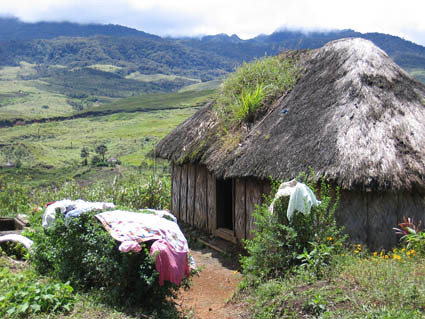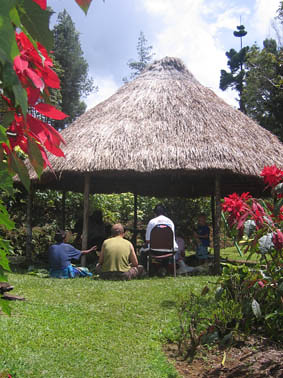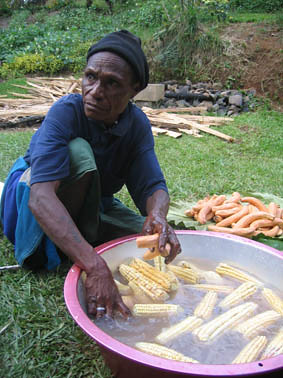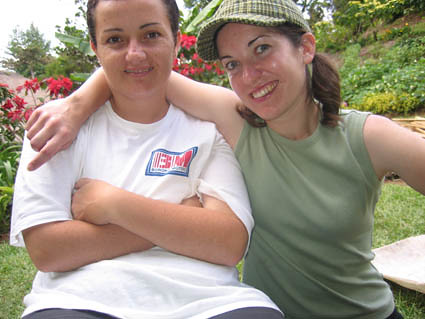"Kickboxing... 24 hours A DAY!"
Con Petropoulous (Eric Bana), The Castle
Back in Melbourne, my weekly exercise consisted of yoga classes during lunch hour on a Thursday. We had a fantastic instructor but the only equipment available were mats for the cold lino floor and some straps for resistance work. I remember several conversations with my colleagues about how extra equipment – like foam blocks and blankets – would have made our classes better, had we the money to spend.
Here in Hagen – my kickboxing classes put such fancies to shame.
Training consists of running, pushups (supposedly on your knuckles), situps and formation kicking and boxing work – all barefoot on a filthy concrete church hall floor. Positively hardcore. And the only equipment used – two pairs of dilapidated gloves and some shin-guards that have lost their elastic – surface for sparring sessions on Fridays.
Training is three times a week – Mondays, Wednesdays and Fridays – with half of the Friday session dedicated to contest. The official start time for training is supposed to be 3pm but, as is the PNG way, classes generally start a little after four and last for almost two hours. When I turned up to my first training session a few weeks ago, I was petrified. There looked to be about 80 people warming up – of varying athletic states. But the ripped, experienced students (proudly in their satin shorts) certainly looked the part. Seriously, these guys seem to have grown a second set of quadriceps. I was quickly told to remove my shoes, pay the one Kina training fee (about 42c) and stand to attention in the student grid formation. And if you think it’d be hard enough doing pushups on a dirty concrete floor under the watchful eye of a national kickboxing champion, try being the only white woman in the room – and add 100 spectators for good measure.
A few days ago I turned up for my first Friday session and it seems everyone else in town had the same idea. The hall’s population doubles on sparring day. Men and women of all ages – even mothers with babies – all gather to watch Highlanders do what they do best – fight.
The women start first. This isn’t just a sport for the men. There’s probably an equal representation of men and women in the class but the men, on the whole, are the more serious. But put two ladies inside the circle and their eyes get the same fierce glint as their fellow male students. These people have NO FEAR whatsoever. Admittedly, they wear shinpads but this, the odd mouthguard and constant reminders from the trainers to keep their guards up are the only things standing between them and a black eye – or worse. Contests only last for about two minutes – but when the ref declares a draw, an extra ten seconds acts as a tiebreaker – and all hell breaks loose as each contestant tries to land kicks and punches to score crucial points in the final moments.
With a tournament in Madang (on the coast) scheduled for this week, the sparring seemed to take on a greater significance on Friday. Champion instructor Joseph (pictured below in the blue shorts) was dealing with a bout of his own – conjunctivitis – but that didn’t stand in the way of him directing his lesson to all and sundry on the dos and don’ts of combat: no kicking knees, no striking a man when he’s down (but on the way down – that’s another story), keep your guards up and NEVER drop your eyes from your opponent’s. When the men took to the floor, it was ON. Several times the (literally) man-made ring had to scuttle back to avoid being caught up in the action. No ropes here. Cheering is loud and spontaneous, laughing in the crowd is met with piercing stares from club members and mortal combatants always finish a fight with embraces best reserved for blood relatives. It’s a fascinating study in human behaviour and – I’ve found after feeling VERY sore for days after training – is a hell of a way to get fit.
Apologies for there being just the one picture. This is the only one that came out clear enough in the dim light of the hall. If I ever end up working up the courage to spar, I’ll be sure to instruct someone to work the camera.
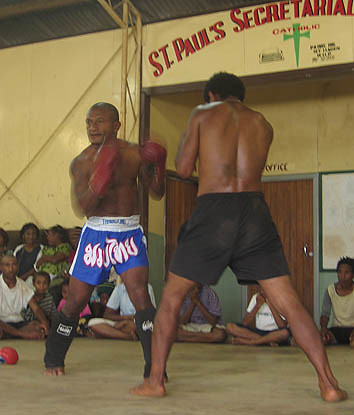
Back in Melbourne, my weekly exercise consisted of yoga classes during lunch hour on a Thursday. We had a fantastic instructor but the only equipment available were mats for the cold lino floor and some straps for resistance work. I remember several conversations with my colleagues about how extra equipment – like foam blocks and blankets – would have made our classes better, had we the money to spend.
Here in Hagen – my kickboxing classes put such fancies to shame.
Training consists of running, pushups (supposedly on your knuckles), situps and formation kicking and boxing work – all barefoot on a filthy concrete church hall floor. Positively hardcore. And the only equipment used – two pairs of dilapidated gloves and some shin-guards that have lost their elastic – surface for sparring sessions on Fridays.
Training is three times a week – Mondays, Wednesdays and Fridays – with half of the Friday session dedicated to contest. The official start time for training is supposed to be 3pm but, as is the PNG way, classes generally start a little after four and last for almost two hours. When I turned up to my first training session a few weeks ago, I was petrified. There looked to be about 80 people warming up – of varying athletic states. But the ripped, experienced students (proudly in their satin shorts) certainly looked the part. Seriously, these guys seem to have grown a second set of quadriceps. I was quickly told to remove my shoes, pay the one Kina training fee (about 42c) and stand to attention in the student grid formation. And if you think it’d be hard enough doing pushups on a dirty concrete floor under the watchful eye of a national kickboxing champion, try being the only white woman in the room – and add 100 spectators for good measure.
A few days ago I turned up for my first Friday session and it seems everyone else in town had the same idea. The hall’s population doubles on sparring day. Men and women of all ages – even mothers with babies – all gather to watch Highlanders do what they do best – fight.
The women start first. This isn’t just a sport for the men. There’s probably an equal representation of men and women in the class but the men, on the whole, are the more serious. But put two ladies inside the circle and their eyes get the same fierce glint as their fellow male students. These people have NO FEAR whatsoever. Admittedly, they wear shinpads but this, the odd mouthguard and constant reminders from the trainers to keep their guards up are the only things standing between them and a black eye – or worse. Contests only last for about two minutes – but when the ref declares a draw, an extra ten seconds acts as a tiebreaker – and all hell breaks loose as each contestant tries to land kicks and punches to score crucial points in the final moments.
With a tournament in Madang (on the coast) scheduled for this week, the sparring seemed to take on a greater significance on Friday. Champion instructor Joseph (pictured below in the blue shorts) was dealing with a bout of his own – conjunctivitis – but that didn’t stand in the way of him directing his lesson to all and sundry on the dos and don’ts of combat: no kicking knees, no striking a man when he’s down (but on the way down – that’s another story), keep your guards up and NEVER drop your eyes from your opponent’s. When the men took to the floor, it was ON. Several times the (literally) man-made ring had to scuttle back to avoid being caught up in the action. No ropes here. Cheering is loud and spontaneous, laughing in the crowd is met with piercing stares from club members and mortal combatants always finish a fight with embraces best reserved for blood relatives. It’s a fascinating study in human behaviour and – I’ve found after feeling VERY sore for days after training – is a hell of a way to get fit.
Apologies for there being just the one picture. This is the only one that came out clear enough in the dim light of the hall. If I ever end up working up the courage to spar, I’ll be sure to instruct someone to work the camera.

